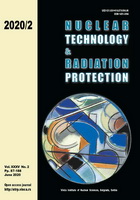
EFFICIENCY CALIBRATION OF A WELL-TYPE HPGe DETECTOR USING EXPERIMENTAL AND MONTE CARLO SIMULATION TECHNIQUES
Pages: 121-129
Authors: Ekaterini Dalaka, Georgios Kuburas, Konstantinos Eleftheriadis, and Marios J. AnagnostakisAbstract
Well-type high-purity germanium detectors are well suited for the analysis of small samples, as they combine high detection efficiency with low background radiation. The well geometry however makes efficiency calibration more difficult than that of ordinary HPGe detectors, due to intense true coincidence and possibly random summing effects. Such a detector has been installed at the Environmental Radioactivity Laboratory of the National Centre for Scientific Research "Demokritos". For the calibration of this detector, experimental and Monte Carlo simulation techniques were applied. To this end, calibration sources were produced from the radionuclides available at the Environmental Radioactivity Laboratory. Starting from the geometrical characteristics of the detector as provided by the manufacturer, using the calibration sources and applying Monte Carlo simulation techniques, the detector was characterized and peak efficiency, as well as total-to-peak calibration curves were produced. The results of the calibration finally obtained by simulation are found to be in good agreement with the respective experimental calibration results.
Key words: gamma ray spectrometry, well-type HPGe detector, Monte Carlo simulation, efficiency calibration
FULL PAPER IN PDF FORMAT (486 KB)
